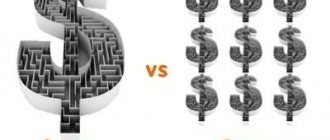In modern economics there are many theories and trends belonging to different economic schools.
Monetarism is one of the most popular trends, whose representatives are convinced that the main cause of economic instability is the disruption of the functioning of monetary circulation and excessive growth of monetary volumes. The basis of the theory of monetarism is the role of the money supply in the economy. This is the main factor of state economic policy. The role of the state in regulation should be within the framework of control over the circulation of money. The market system is a fairly healthy organism with a flexible system of self-regulation - this is what the monetarist approach is based on. However, one must understand that this theory is not unique; it should be applied, taking into account certain conditions and real situations and combined with measures of other areas of economic policy.
It is based on the work of central banks in matters of money supply.
- 1 Historical data 1.1 First monetary theory
- 1.2 Since the mid-70s, the theory of monetarism has gained the greatest popularity
Key Features
Monetarism is a theory that focuses on the macroeconomic effects of the money supply and the activities of central banks. It was formulated by Milton Friedman. In his opinion, an excessive increase in the money supply in circulation irreversibly leads to inflation. The central bank's job is solely to maintain price stability. The school of monetarism originates from two historically antagonistic movements: tight monetary policy, which was common in the late 19th century, and the theories of John Maynard Keynes, which became widespread in the interwar period after an unsuccessful attempt to restore the gold standard. Friedman focused his research on price stability, which depends on the balance between the supply and demand of money. He summarized his conclusions in his joint work with Anna Schwartz, “The Monetary History of the United States in 1867-1960.”
Demonetization
The demonetization of gold caused the loss of an important component of the general equivalent: the abstract value of the golden substance of money and the use value of money were lost. The general equivalent retained only the formal use and exchange value of money.” The external embodiment of value in the credit form of money is a debt obligation as a carrier of commodity capital.
The credit nature of modern money is manifested in the methods of its issue, which are associated with lending by the banking system to the state and economic entities. The supply of credit money is therefore closely related to the deposit base of the banking system. It should also be emphasized that when initially the main forms of credit money were checks, bills, banknotes (as the main form of deposit money), the main trend of the last century was the development of this form of credit money as deposit electronic money.
Monetarists reject the credit nature of current money, since this interpretation indicates the presence of a passive reaction of the money supply to changes in trade turnover, which evokes the exogenous principle of issuing means of payment in monetarist schemes.
In order to confirm the regulation of the money supply by the central bank, monetarists use the concept of a money multiplier, which is based on control of the monetary base. The monetary base includes: the amount of cash that is issued into circulation, balances in the central bank and in reserve accounts of commercial banks. The “base-multiplier” model plays an important role in substantiating the monetarist thesis about the autonomy of the money supply.
Description of the theory
Monetarism is a theory that views inflation as a direct consequence of an excessive supply of money. This means that responsibility for it lies entirely with the central bank. Friedman initially proposed a fixed monetary rule. According to it, the money supply should automatically increase by k% annually. Thus, the central bank will lose freedom of action, and the economy will become more predictable. Monetarism, whose representatives believed that thoughtless manipulations of the money supply cannot stabilize the economy, is primarily long-term planning that prevents emergencies, rather than attempts to quickly respond to them.
Unemployment
Continuing to study the emergence of monetarism, as well as its further development, it is necessary to raise the issue of employment. After all, this topic occupies an important place in the theory under consideration, as well as in the argumentation of its supporters.
So, there is the concept of natural unemployment. It is also called voluntary. A normal phenomenon in which the price level and real wages of the population are stable.
Monetarists believe that disruption of this equilibrium can only occur in the short term. What's happening? With increased employment levels, inflation rises. When it is low, it decreases. The medium-term outlook is that the market will eventually return to equilibrium.
Based on these statements, another idea of monetarism was formed. Friedman and his supporters insisted that it was necessary to direct employment policy to equalize the notorious dynamics of the unemployment rate.
Denying the need for a gold standard
Monetarism is a trend that became widespread after World War II. Most of its representatives, including Friedman, view the gold standard as an impractical vestige of the old system. Its undoubted advantage is the existence of internal restrictions on the growth of money. However, population growth or increased trade irreversibly lead in this case to deflation and a drop in liquidity, since in this case everything depends on the production of gold and silver.
Money
Wealth is money. Possession of wealth can be expressed in various forms:
- in cash “live” money;
- electronic money;
- cryptocurrency;
- securities, including investment funds;
- real estate, in the form of land, as well as other property in the form of jewelry, antiques, and other durable items.
The value of some forms of storing money increases, while others decrease.
The demand for money is determined not only by the return on assets, but also by ways of storing existing money that can increase initial income.
Monetarism studies the circulation of money, including its storage, in different forms and in aggregate.
Becoming
Clark Warburton is credited with the first monetary interpretation of business fluctuations. He described it in a series of articles in 1945. This is how the modern trends of monetarism were born. However, the theory became widespread after Milton Friedman introduced the quantity theory of money in 1965. It existed long before him, but the dominant Keynesianism at the time called it into question. Friedman believed that expansion of the money supply would lead not only to an increase in savings (if supply and demand are in balance, people have already made the necessary savings), but also to an increase in aggregate consumption. And this is a positive fact for national production. The increase in interest in monetarism is also associated with the inability of Keynesian economics to overcome unemployment and inflation after the collapse of the Bretton Woods system in 1972 and the oil crises of 1973. These two negative phenomena are directly interrelated; solving one of the problems leads to an exacerbation of the other.
In 1979, US President Jimmy Carter appointed Paul Volcker to head the Federal Reserve. He limited the money supply according to the Friedman rule. The result was price stability. Meanwhile, in Great Britain, the representative of the Conservative Party, Margaret Thatcher, won the elections. Inflation during that period rarely fell below 10%. Thatcher decided to use monetarist measures. As a result, by 1983 the inflation rate dropped to 4.6%.
Predecessors of monetarism[edit | edit code]
The understanding that price changes depend on the volume of the money supply has come to economic theory since ancient times. So, back in the 3rd century, the famous ancient Roman lawyer Julius Paulus argued about this. Later in 1752, the English philosopher D. Hume, in his “Essay on Money,” studied the relationship between the volume of money and inflation. Hume argued that an increase in the money supply leads to a gradual increase in prices until they reach their original proportion with the amount of money in the market. These views were shared by the majority of representatives of the classical school of political economy. By the time J. S. Mill wrote “Principles of Political Economy,” a quantitative theory of money had already been developed in general [1]. To Hume's definition, Mill added a clarification about the need for constancy in the structure of demand, since he understood that the supply of money can change relative prices. At the same time, he argued that an increase in the money supply does not automatically lead to an increase in prices, because monetary reserves or product supply can also increase in comparable volumes[2].
Within the framework of the neoclassical school, I. Fisher in 1911 gave the quantity theory of money a formal form in his famous equation of exchange:
MV = PQ {displaystyle MV=PQ} ,
The modification of this theory by the Cambridge school (Fisher) formally looks like this:
M = k PY {displaystyle M=kPY} ,
Fundamentally, these approaches differ in that Fisher attaches great importance to technological factors, and representatives of the Cambridge school - to consumer choice. At the same time, Fisher, unlike A. Marshall and A. Pigou, excludes the possibility of the interest rate influencing the demand for money[5].
Despite scientific recognition, the quantity theory of money did not go beyond academic circles. This was due to the fact that before Keynes, a full-fledged macroeconomic theory did not yet exist, and the theory of money could not be applied in practice. And after its appearance, Keynesianism immediately took a dominant position in the macroeconomics of that time. During these years, only a small number of economists developed the quantity theory of money, but despite this, interesting results were obtained. So, K. Warburton in 1945-53. found that an increase in the money supply leads to higher prices, and short-term fluctuations in GDP are related to the money supply. His works anticipated the emergence of monetarism, however, the scientific community did not pay much attention to them[1].
Nobel laureate M. Friedman
We can say that the theory of monetarism, no matter how strange it may sound, began with Keynesianism. Milton Friedman, at the beginning of his academic career, was a supporter of fiscal regulation of the economy. However, he later came to the conclusion that it was wrong to intervene in the national economy by changing government spending. In his famous works, he argued that “inflation is always and everywhere a monetary phenomenon.” He opposed the existence of the Federal Reserve, but believed that the task of the central bank of any state was to maintain the demand and supply of money in balance.
Notes[edit | edit code]
- ↑ 1 2 3 4 5 6 Moiseev S. R.
The rise and fall of monetarism // Questions of Economics. - 2002. - No. 9. - P. 92-104. - ↑ M. Blaug.
Economic thought in retrospect. - M.: Delo, 1996. - P. 181. - 687 p. — ISBN 5-86461-151-4. - ↑ 1 2 3 4 Sazhina M. A., Chibrikov G. G.
Economic theory. — 2nd edition, revised and expanded. - M.: Norma, 2007. - 672 p. — ISBN 978-5-468-00026-7. - ↑ Mishkin, 1999, p. 548-549.
- ↑ Mishkin, 1999, p. 551.
- ↑ 1 2 B. Snowdon, H. Vane.
Modern macroeconomics and its evolution from a monetarist point of view: an interview with Professor Milton Friedman. Translation from Journal of Economic Studies (Russian) // Ekovest. - 2002. - No. 4. - P. 520-557. - ↑ Mishkin, 1999, p. 563.
- ↑ S. N. Ivashkovsky.
Macroeconomics: Textbook. — 2nd edition, corrected and expanded. - M.: Delo, 2002. - P. 158-159. — 472 p. — ISBN 5-7749-0178-5. - ↑ 1 2 K. R. McConnell, S. L. Brew.
Economics: principles, problems and policies. — translation from the 13th English edition. - M.: INFRA-M, 1999. - P. 353. - 974 p. — ISBN 5-16-000001-1. - ↑ Course of economic theory / Ed. Chepurina M. N., Kiseleva E. A. - Kirov: ASA, 1995. - P. 428-431. — 622 p.
- ↑ M. Blaug.
Economic thought in retrospect. - M.: Delo, 1996. - P. 631-634. — 687 p. — ISBN 5-86461-151-4. - ↑ N. G. Mankiw.
Macroeconomics. - M.: MSU, 1994. - P. 602-604. — 736 p. — ISBN 5-211-03213-6.
"Monetary History of the United States"
This famous work, which became the first large-scale study using the methodological principles of the new direction, was written by Nobel laureate Milton Friedman in collaboration with Anna Schwartz. In it, scientists analyzed statistics and came to the conclusion that the supply of money significantly influenced the US economy, especially the passage of business cycles. This is one of the most outstanding books of the last century. The idea of writing it was suggested by Federal Reserve Chairman Arthur Burns. A Monetary History of the United States was first published in 1963.
Origins of the Great Depression
Work on the book "A Monetary History of the United States" has been carried out by Friedman and Schwartz under the auspices of the National Bureau of Economic Research since 1940. It was published in 1963. The chapter on the Great Depression appeared two years later. In it, the authors criticize the Federal Reserve for inaction. In their opinion, he should have maintained a stable money supply and provided loans to commercial banks, rather than driving them into mass bankruptcy. Monetary History uses three main indicators:
- Cash ratio on individuals' accounts (if people believe in the system, then they leave more on their cards).
- The ratio of deposits to bank reserves (in stable conditions, financial institutions borrow more).
- Money of “increased efficiency” (that which serves as cash or highly liquid reserves).
Based on these three indicators, the money supply can be calculated. The book also discusses the problems of using the gold and silver standards. The authors measure the velocity of money and try to find the optimal way for central banks to intervene in the economy.
Contribution to science
Thus, monetarism in economics is the direction that first presented a logical rationale for the Great Depression. Previously, economists saw its origins in the loss of consumer and investor confidence in the system. Monetarists responded to the challenges of new times by proposing a new way to stabilize the national economy when Keynesianism no longer worked. Today, many countries use a modified approach, which involves greater government intervention in the economy to regulate the speed of circulation of money and its quantity in circulation.
Criticism of Friedman's conclusions
According to Alan Blinder and Robert Solow, fiscal policy becomes ineffective only when the elasticity of money demand is zero. However, in practice this situation does not occur. Friedman believed that the cause of the Great Depression was the inaction of the US Federal Reserve Bank. However, some economists, such as Peter Temin, disagree with this conclusion. He believes that the origins of the Great Depression are exogenous rather than endogenous. In one of his works, Paul Krugman argues that the financial crisis of 2008 showed that the state is not able to control “broad” money. In his opinion, their supply has almost nothing to do with GDP. James Tobin notes the importance of Friedman and Schwartz's findings, but questions their proposed measures of money velocity and their impact on business cycles. Barry Eichengreen argues that it was impossible for the Federal Reserve to remain active during the Great Depression. In his opinion, the gold standard prevented the increase in the supply of money. He also questions the rest of Friedman and Schwartz's conclusions.
Money supply and money demand
Monetarism is an economic theory, according to which the number of money in circulation is a determining factor in the formation of economic conditions and there is a direct connection between changes in the circulation of the money supply and the size of the national gross product. Appeared in the USA in the mid-50s of the XX century. Supporters of monetarism believe that government measures to stimulate demand, advised by Keynesians, not only do not improve the state of the economy, but give rise to other imbalances and crisis downturns.
The monetarist version of the numerical theory of money differs from its traditional variants. The pure theory of the demand for money, which was put forward by M. Friedman, the leading theorist of the new numerical theory, is set forth in his essay “The Quantity Theory of Money: A New Formulation” (1956). The purpose of revising the quantitative classical theory was to find its connection with the laws of microeconomics. The main attention is focused on studying the problem of demand for cash balances, that is, the patterns of formation of needs for money from economic entities. It must be emphasized that in the monetarist concept, the demand for money was considered as a relatively stable value that ensures the stability of economic development. This premise in the study did not fundamentally change the essence of the numerical theory, since “...a stable function of the demand for money is only another method of expressing the constancy of the velocity of circulation of money, which...has always been a prerequisite of the numerical theory. But in the monetarist version, rigidly determined speed formulas are modified by a probabilistic connection, which allows significant fluctuations in the quantitative values of this indicator.”
It is obvious that the monetarist concept is a future development of the Cambridge version of the numerical theory of money. The question of the nature of income on assets that serve as an alternative to money and the budget (resource) constraint is carefully developed. Friedman's model of demand for money is based on the behavior of two types of economic entities: firms and households. For the former, money is a source of storing wealth, and for the latter, it is a capital asset. At the same time, money is considered as a component of interchangeable and accumulated assets. The main function of money as an element of the asset portfolio of economic entities is to create a liquidity reserve and ensure payments. Taking into account this basic function of money, a list of factors is determined, under the influence of which the demand of economic entities for monetary assets is formed to construct the demand function for money.
This equation takes into account the price impact factor, which determines the inverse relationship between the price level and the purchasing power of money. For these purposes, not nominal, but deflated by price level (real) cash balances of economic entities are introduced into the equation.
On practice
Monetarism in economics arose as a direction that was supposed to help cope with the problems after the collapse of the Bretton Woods system. A realistic theory must explain the deflationary waves of the late 19th century, the Great Depression, and the stagflation after the Jamaica Conference. According to monetarists, the velocity of money directly affects fluctuations in business activity. Thus, the cause of the Great Depression is the lack of money supply, which led to a drop in liquidity. Any major fluctuations and instability in prices are due to the wrong policies of the central bank. An increase in the money supply in circulation is usually associated with the need to finance government spending, so it needs to be reduced. Macroeconomic theory before the 1970s, on the contrary, insisted on their expansion. The recommendations of monetarists have proven their effectiveness in practice in the USA and Great Britain.
Topic 9. MONETARY POLICY
Objectives and instruments of monetary policy.Monetary (credit and monetary) policy is one of the types of stabilization, or countercyclical, policies aimed at smoothing out cyclical fluctuations in the economy (along with fiscal, foreign trade, foreign exchange, etc. policies). The goal of any stabilization and, consequently, monetary policy of the state is to ensure, firstly, economic growth, secondly, full employment of resources, thirdly, stability of the price level, and fourthly, balance of payments equilibrium. To stabilize the economy, the state pursues a stimulating (expansionist) economic policy during a recession and a contractionary (contractive) policy during a boom.
Monetary policy influences economic conditions by affecting aggregate demand
.
The object of regulation is the money market
, and above all
the money supply
.
The country's central bank determines and implements monetary policy, but changes in the supply of money in the economy occur as a result of operations not only of the Central Bank, but also of commercial banks, as well as decisions of the non-banking sector (households and firms).
Tactical goals (targets) of the Central Bank’s monetary policy can be: a) control over the supply of money
(money supply);
b) control over the level of
interest rates;
c) control over the exchange rate
of the national monetary unit (national currency).
The Central Bank changes the money supply by influencing the reserves of commercial banks
(and therefore on their borrowing capacity) and
the money multiplier
. The actual volume of money supply is the result of the operations of commercial banks in accepting deposits and issuing loans. An increase in the money supply corresponds to a stimulating, and a contraction of the money supply corresponds to a contractionary monetary policy.
To the tools
Monetary policies that enable the central bank to control the amount of money supply include: 1) changing the required reserve ratio; 2) change in the discount interest rate (refinancing rate); 3) open market operations.
The first instrument of monetary policy is changing the required reserve ratio.
Required reserves represent the part of deposits of commercial banks that they do not have the right to lend and must be kept in the form of interest-free deposits with the Central Bank.
The amount of required reserves ( R
oblig) is determined in accordance with the required reserve rate
(rr),
which is established by the Central Bank and represents a percentage of the total amount of deposits of a commercial bank
(D).
For each type of deposit (demand, savings, time deposits) its own required reserve norm is established, and the higher the degree of liquidity of the deposit, the higher this norm. For example, for demand deposits the required reserve ratio is higher than for time deposits. If the Central Bank increases the required reserve ratio, then the money supply decreases for two reasons:
>
firstly, the lending capabilities of a commercial bank are reduced, i.e. the amount of reserves that the bank can issue on credit.
As is known, credit opportunities represent the difference between the amount of deposits and the amount of required reserves (K = D – R
liability).
As the required reserve ratio increases, the amount of required reserves that a commercial bank does not have the right to use for lending purposes increases, and therefore the lending capabilities of commercial banks decrease. For example, if the total amount of deposits in a commercial bank is $1,000, then with a required reserve ratio of 10% (rr
1
=
0.1), its lending capabilities, i.e., the amount of funds that it can lend, will be:
K1 = 1000–1000?
0.1 = 900, and with a required reserve ratio of 20% (rr
2 = 0,2):
K2 = 1000–1000? 0.2 = 800;
>
secondly, the required reserve ratio determines the value of the bank multiplier, which is equal to
mult bank = 1 / rr;
an increase in the required reserve ratio from 10 to 20% reduces the value of the banking multiplier from 10 (1 / 0.1) to 5 (1 / 0.2).
Thus, a change in the required reserve ratio affects the money supply through two channels: both through a change in the lending capabilities of commercial banks and through a change in the value of the multiplier. As a result, even minor changes in the required reserve ratio can lead to significant and unpredictable changes in the money supply.
The stability of the required reserve ratio serves as the basis for the smooth conduct of business by commercial banks, therefore this instrument, as a rule, is not used in developed countries for the purposes of ongoing control over the supply of money. A change in the required reserve rate occurs only in cases where the Central Bank intends to achieve a significant expansion or contraction of the money supply (for example, in the USA this instrument was last used during the crisis of 1974–1975). Moreover, since the early 1980s. the procedure for revising this indicator in developed countries has become quite cumbersome and technically complex, so it has ceased to be a means of prompt and flexible management of the money supply.
The second instrument of monetary policy is regulation of the discount rate
, which in Russia is called the refinancing rate.
The discount rate is the interest rate at which the Central Bank provides loans to commercial banks. Commercial banks resort to loans from the Central Bank if they unexpectedly face the need to urgently replenish reserves or to get out of a difficult financial situation. In the latter case, the Central Bank acts as a lender of last resort
(for more information on the functions of the Central Bank, see topic 8). Funds received as a loan from the Central Bank (through the “discount window”) at the discount rate represent additional reserves of commercial banks, the basis for a multiplicative increase in the money supply; Thanks to this, by changing the discount rate, the Central Bank can influence the money supply.
Commercial banks view the discount rate as the cost associated with acquiring reserves. The higher the discount rate, the fewer loans commercial banks take from the Central Bank and therefore the smaller the amount of reserves that they can issue on credit. And the smaller the lending capabilities of banks, the smaller the volume of loans they provide and, consequently, the smaller the money supply. If the discount interest rate decreases, this encourages commercial banks to take loans from the Central Bank to increase their reserves. The reserves of commercial banks increase, credit opportunities expand, and the process of a multiplicative increase in the money supply begins.
Thus, in contrast to the impact on the money supply caused by a change in the required reserve ratio, a change in the discount interest rate affects only the amount of lending capacity of commercial banks
, without changing the value of the bank multiplier.
Changing the discount rate is not the most flexible and operative tool of monetary policy. This is primarily due to the fact that the volume of loans received by commercial banks by borrowing from the Central Bank is relatively small in developed countries and, for example, in the USA does not exceed 2–3% of the total value of bank reserves. The fact is that the Central Bank does not allow commercial banks to abuse the opportunity to obtain loans from it. It provides funds only if, according to experts, the bank really needs help, and the reasons for its financial difficulties are objective. As a result, a change in the discount rate is more likely to be considered as an information signal about the intended direction of the Central Bank's policy. For example, the announcement of a proposed increase in the Central Bank's discount rate informs economic agents of its intention to pursue a contractionary monetary policy (usually to combat inflation). The discount rate acts as a kind of benchmark for establishing the interbank interest rate (i.e., the interest rate at which commercial banks provide loans to each other) and the interest rate at which commercial banks issue loans to the non-bank sector of the economy (households and firms). When the Central Bank increases the interest rate, the money supply contracts (a leftward shift in the money supply curve from MS
1 to
MS
2), and the market interest rate increases (from
R
1 to
R
2) (Fig. 9.1,
a
).
Therefore, even if the Central Bank only announces a possible increase in the interest rate, economic agents know that this measure should lead to a decrease in the money supply, accordingly, the economy reacts quickly, commercial banks increase the interest rate on loans, money (loans) become “expensive” , the money supply is shrinking. Rice.
9.1. The effect of a change in the money supply on the interest rate: a
) decrease in the money supply;
b
) increase in money supply
The most important and operational means of controlling the money supply are open market operations -
purchase and sale by the central bank of government securities in the secondary securities markets (the activities of the Central Bank in the primary securities markets are, as a rule, prohibited by law). The objects of open market transactions are primarily treasury bills and short-term government bonds.
Government securities are bought and sold to commercial banks and the public. The purchase of government bonds by the central bank in both the first and second cases increases the reserves of commercial banks. If the central bank buys securities from a commercial bank, it increases the amount of reserves in its account with the central bank. Thus, the total volume of reserve deposits of the banking system increases, which increases the lending capabilities of banks and leads to deposit (multiplicative) expansion. Thus, like a change in the discount interest rate, open market operations affect changes in the supply of money, affecting only the value of the lending capabilities of commercial banks, and there is no change in the value of the bank multiplier.
If the Central Bank buys securities from the public (households or firms), then, provided that the seller deposits the amount received from the Central Bank into his account with a commercial bank, the commercial bank's reserves will increase and the money supply will increase for the same reasons as in the case when securities are sold by a commercial bank. The difference, however, is that when the seller is a commercial bank, its reserves increase, as already noted, by the entire amount of the bond purchase. And if securities are sold by a private person, then only the amount in current accounts (the amount of deposits) increases, so the lending capabilities of the banking system will be less, since part of the deposit, in accordance with the required reserve norm, must be allocated to required reserves.
Purchase
securities by the central bank as a means of quickly influencing the economic situation during a recession.
If the economy is “overheated,” then the Central Bank must sell
government securities on the open market. This significantly limits the lending capabilities of commercial banks, reducing their reserves, which leads to a multiplicative contraction of the money supply both when the Central Bank sells government securities to commercial banks and when buyers are households and firms (non-banking sector). This has a dampening effect on economic activity.
The possibility of conducting operations on the open market is due to the fact that the purchase and sale of government securities from the Central Bank is beneficial to commercial banks and the population. The fact is that the price of a bond and the interest rate are inversely related and when the Central Bank buys government bonds, the demand for them increases, which leads to an increase in their price and a fall in the interest rate. Owners of government bonds (both commercial banks and the public) begin to sell them to the central bank, as increased prices allow them to generate income from the difference between the price at which the bond was purchased and the price at which it is sold. Conversely, when the Central Bank sells government securities, their supply increases, which leads to a fall in their price and an increase in the interest rate, making their purchase profitable.
Thus, injections into bank reserves as a result of purchases and withdrawals from them as a result of sales of government securities by the central bank lead to a rapid response of the banking system, operate more subtly than other instruments of monetary policy, and therefore open market operations represent the most effective, a quick and flexible way to influence the amount of money supply.
Types of monetary policy.
There are two types of monetary policy: stimulating and contractionary.
Stimulating
Monetary policy is carried out during
a recession
, with the goal of “cheering up” the economy, stimulating the growth of business activity and is used as a means of combating
unemployment
.
This policy consists of the central bank taking measures to increase
the supply of money.
Its instruments are a reduction
in reserve requirements and the discount rate, and
the purchase of
government securities by the central bank.
An increase in the supply of money leads to an increase in aggregate demand (a shift of the aggregate demand curve to the right from AD
1 to
AD
2), which ensures an increase in output from
Y
1 to
Y
* and, therefore, overcoming the recession and using resources at their full employment level (Fig. 9.2,
a
).
Containing
Monetary policy is carried out during a period
of boom
, “overheating” of the economy, is aimed at reducing business activity and is considered as a means of combating
inflation.
This policy consists of the central bank using measures to
reduce
the money supply.
Such measures include: increasing
the norm of reserve requirements and the discount rate, and
the sale
of government securities by the central bank.
A decrease in the supply of money reduces aggregate demand (a leftward shift in the aggregate demand curve from AD
1 to
AD
2), which ensures a decrease in the price level from
P
1 to
P
2 (therefore acts as an anti-inflationary measure) and a return of the output value to its potential level
Y
* (Fig. 9.2,
b
).
The impact of monetary policy occurs in the short term
period and is aimed at smoothing out cyclical fluctuations in the economy (stabilizing the economy) by influencing
aggregate demand
by changing the value of money supply by the central bank.
The impact of monetary policy on the economy.
The mechanism that shows how changes in the situation in the money market affects changes in the situation in the market for goods and services (real market) is called the
“monetary transmission mechanism”
, or
“monetary transmission mechanism”
.
The connecting link between the money and commodity markets is the interest rate. The equilibrium interest rate is formed in the money market according to the relationship between the demand for money and the supply of money. By changing the money supply, the Central Bank can influence the interest rate. The relationship between the interest rate and the money supply is inverse: if the money supply decreases, the interest rate rises (Fig. 9.1, a
);
if the money supply increases, the interest rate falls (Fig. 9.1, b
).
Being the price of borrowed funds (the price of credit), the interest rate affects the investment costs of firms. The higher the interest rate, the less loans firms will take out and the lower the total investment expenditure and therefore the lower the output. Rice.
9.2. The impact of monetary policy on the economy: a)
expansionary monetary policy;
b)
contractionary monetary policy
The mechanism of monetary transmission during a recession is graphically depicted in Fig. 9.3 and can be represented by the following logical chain of events. Because the economy is in recession ?
Does the Central Bank purchase government securities
?
Are commercial bank reserves increasing
?
Are their credit opportunities expanding
?
Are banks providing more loans
?
the supply of money increases multiplicatively (shift of the money supply curve to the right from
MS
1 to
M S
2 - Fig. 9.3,
a)
? the interest rate (credit price) falls (from
R 1
to
R 2)
? Are companies happy to take cheaper loans
?
the amount of investment costs is growing (from
I
1 to
I
2 - Fig. 9.3,
b
)?
aggregate demand increases (shift to the right of the aggregate demand curve from AD
1 to
AD
2 - Fig. 9.3,
c)
? production volume increases (from
Y
1 to
Y
*).
This policy, carried out with the aim of exiting the recession, is called the “cheap money policy”
and corresponds to
an expansionary
monetary policy.
Rice.
9.3. “Cheap money” policy: a
) money market;
b)
investment market;
c)
market for goods and services
Accordingly, the policy implemented by the Central Bank during a boom (“overheating”) and aimed at reducing business activity in order to combat inflation is called “dear money policy”
and is consistent with
contractionary
monetary policy.
Graphically, this type of monetary policy is depicted in Fig. 9.4 and can be represented by the following logical chain of events. Because the economy is “overheated” ?
The Central Bank sells government securities
?
Are commercial bank reserves decreasing
?
Are banks' lending capabilities declining
?
the money supply decreases multiplicatively (shift of the money supply curve to the left from
MS
1 to
MS
2 - Fig. 9.4,
a)
? interest rate (credit price) increases (from
R
1 to
R
2)
?
Is the demand for expensive loans from firms falling
?
the amount of investment costs is reduced (from
I
1 to
I
2 - Fig. 9.4,
b)
? aggregate demand decreases (shift to the left of the aggregate demand curve from
AD
1 to
AD
2 - Fig. 9.4,
c)
? production volume decreases, returning to its potential level
Y
*, and the price level falls (from
P
1 to
P
2).
In both cases, the economy will stabilize.
Rice.
9.4. “Dear money” policy: a)
money market;
b)
investment market;
c)
market for goods and services
Table of contents
Modern monetarism
Today, the Federal Reserve uses a modified approach. It assumes greater government intervention in the event of temporary instability in market dynamics. Among other things, it should regulate the speed of circulation of money. European colleagues prefer more traditional monetarism. However, some researchers believe that this policy was the reason for the weakening of currencies in the late 1990s. From this time on, the conclusions of monetarism began to be called into question. Disputes about the role of this school of economic thought in trade liberalization, international investment and effective central bank policies continue to this day.
However, monetarism remains an important theory on which new ones are built. His findings are still relevant and deserve detailed study. Friedman's work is widely known in the scientific community.
Money balances in monetarism
The fact that cash balances are treated as an asset that is comparable to other types of assets suggests that Friedman's theory is expressed in terms of stocks, not flows. This approach makes it possible to analyze the proposed equation from the point of view of real income ( ). This variable can be interpreted as a budget constraint. Comparing the profitability of alternative assets allows an economic entity to make a decision about what part of the total wealth should be saved in the form of money. But this procedure does not make it possible to determine the level of required cash balances. This is made possible by introducing total wealth into the equation along with relative returns. Real income ( ) thus represents the wealth constraint. Given these propensities (expressed by the variable ) economic agents increase income, taking into account the budget constraint, determining their total wealth and the relative income that is obtained from the assets they have.
The emergence of the monetarist concept of the demand for money for several decades captivated economic thought in the search for “statistically reliable” equations for the demand for money. In particular, a number of works by J. Scadding and J. Judd, S. Goldfeld, and A. Meltzer are devoted to this issue. “Equations of this type became very popular and received the status of “standard” money demand equations.”
But further research revealed the inaccuracy of the forecast of the demand for money, which is obtained using such equations, which indicates the instability of the demand for cash balances. The main problem was the money supply factor, which was not taken into account in monetarist models. As the American economist N. Kaldor emphasized, “Friedman’s persistent attempts to explain the numerical theory with the help of a stable function of the demand for money or a stable rate ... are placed in a critical dependence on whether the number of money is an exogenous quantity, which is set at the discretion of the monetary control authorities, regardless of demand money."
The question of the reality and possibility of exogenous monetary emission is inextricably linked with the credit nature of current money. Credit money is a collective concept. “The universal exchange equivalent, which is embodied in credit money, corresponds to the equivalent of the commodity world. It can be considered as an evolutionary form of the universal classical equivalent.











